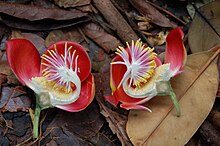Cannonball tree
| Cannonball tree | ||||||||||||
|---|---|---|---|---|---|---|---|---|---|---|---|---|

Cannonball Tree ( Couroupita guianensis ) |
||||||||||||
| Systematics | ||||||||||||
|
||||||||||||
| Scientific name | ||||||||||||
| Couroupita guianensis | ||||||||||||
| Aubl. |
The cannonball tree ( Couroupita guianensis ) is a tree species from the family of lecythidaceae (Lecythidaceae). He is one of only three kinds comprehensive genus Couroupita .
description
Vegetative characteristics
The mostly semi-evergreen cannonball tree reaches a height of up to 30–35 meters. The bark is brownish-gray and relatively smooth and somewhat textured to slightly cracked to scaly.
The obovate to lanceolate, simple and alternate, whole-margined leaves are crowded at the branch ends . They are 8 to 30, rarely up to 60 centimeters long and 3 to 10 centimeters wide. The upper side of the leaf is bare, on the underside the veins and especially the armpits of the veins are hairy. At the base, the leathery leaf is pointed to wedge-shaped in the 0.5 to 3 cm long, short petiole, the front end is pointed or pointed to rounded or rounded. The veins are pinnate and raised on the underside. The leaves are completely shed up to four times a year and replaced with newly sprouted ones within a week.
Generative characteristics
The inflorescence arises from kauliflor on the trunk or ramiflor on older branches. It is mostly unbranched and racemose , but grows over a long period of time, branches out into panicles now and then , and after several years it can become a few meters long. New flowers always form at the tip , rarely leaves also form at the inflorescence axis .
The single, pleasantly scented and hermaphrodite flower sits on a 1.2 to 6 centimeter long peduncle and measures 5 to 6 centimeters in diameter. The flower stalk has a "joint" at the top. The flowers have small bracts and bracts . The six small, triangular and yellowish sepals are fused together except for one tip. The six large, obovate petals are red-yellowish on the outside, red to orange-pink on the inside, sometimes a bit whitish at the base. About 600 to 700 stamens are fused with the base of their stamens to form a wide ring. The ring continues on one side in the shape of a tongue and hood. There are no stamens in the curve of this outer white to slightly pink hood, only further forward. These stamens on the process are grown together in groups of three to six, sterile staminodes often occur here. The pollen of the ring and hood stamens is different. The semi-protruding, multi-chambered ovary , with a short stylus , is surrounded by a cup-shaped flower cup and on top by the stamen. The flowers do not carry any nectar .
Mostly different bees were observed as flower visitors , for example from the genera Apis , Bombus , Trigona and Xylocopa . Even wasps and some flies were observed. The flowers are also pollinated by bats .
Large, reddish-brown to greyish, spherical and multi-seeded fruits with a diameter of 12 to 24 centimeters develop from pollinated flowers. Remains of the upper part of the ovary can be seen in the front third of the fruit. The fruits have a lignified, warty to scabbed skin and fall closed from the tree. They contain 80 to 300 oval and hairy seeds which are embedded in a fibrous, soft and reddish-brown pulp that turns bluish-green in the air.
The number of chromosomes is 2n = 36.
distribution
The species is native to northern South America. In the north, the area extends to Panama and Costa Rica (possibly only planted there), in the south-west along the eastern slope of the Andes to Ecuador , in the south-east to the mouth of the Amazon in Brazil. Due to the wide distribution as an ornamental wood, the natural area cannot be determined with certainty. The species is also native to Vietnam in Asia .
use
The fruits can be eaten, but due to the putrid smell, they take a lot of getting used to.
The soft and light wood is not particularly valuable.
literature
- Ghillean T. Prance: Couroupita . In: Scott A. Mori, Ghillean T. Prance (Eds.): Flora Neotropica Monograph. Lecythidaceae Part II. The Zygomorphic-flowered New World Genera . tape 21 , no. 2 , 1990.
- TK Lim: Edible Medicinal And Non Medicinal Plants. Volume 3: Fruits , Springer, 2012, ISBN 978-94-007-2533-1 , pp. 133-137.
Individual evidence
- ↑ Couroupita guianensis at National Tropical Botanical Garden, Hawaii, accessed on September 30, 2019 (under Connections, with many pictures).
- ↑ Couroupita guianensis at Tropicos.org. In: IPCN Chromosome Reports . Missouri Botanical Garden, St. Louis
Web links
- Couroupita guianensis at New York Botanical Garden, accessed September 30, 2019 (with many images).
- Couroupita guianensis at Useful Tropical Plants
- Couroupita guianensis at Pitchandikulam Forest Virtual Herbarium.
- Couroupita guianensis in the endangered Red List species the IUCN 2006. Posted by Miter, 1998. Retrieved on 6 May, 2006.



